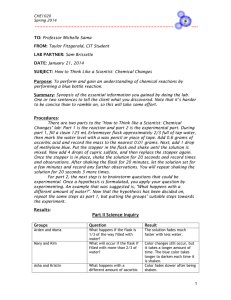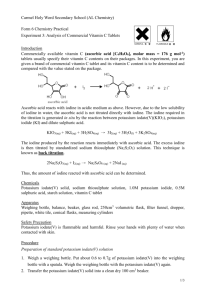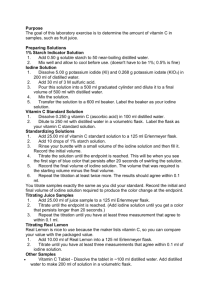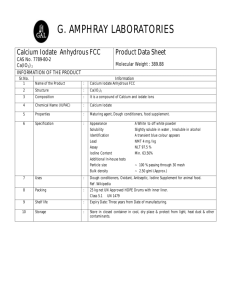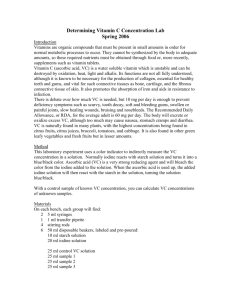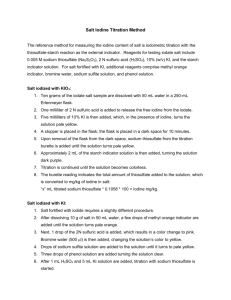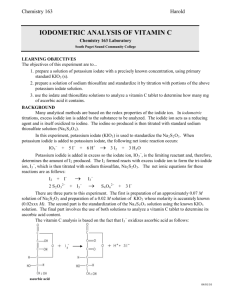Determination of Vitamin C Concentration by Titration
advertisement
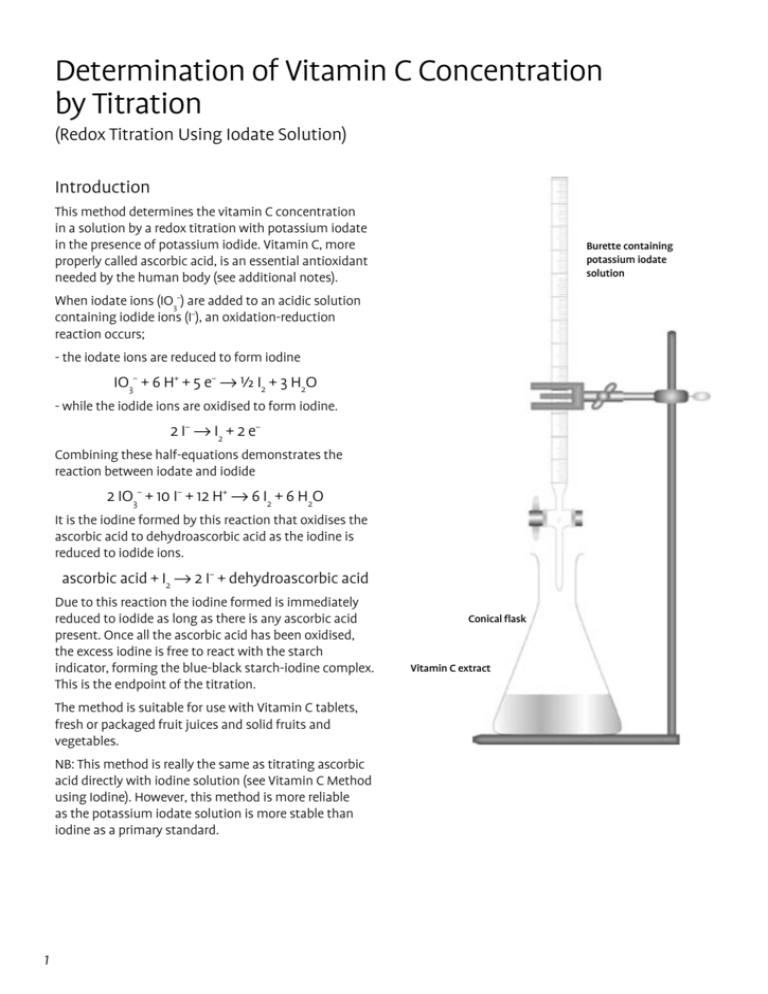
Determination of Vitamin C Concentration by Titration (Redox Titration Using Iodate Solution) Introduction This method determines the vitamin C concentration in a solution by a redox titration with potassium iodate in the presence of potassium iodide. Vitamin C, more properly called ascorbic acid, is an essential antioxidant needed by the human body (see additional notes). Burette containing potassium iodate solution When iodate ions (IO3−) are added to an acidic solution containing iodide ions (I−), an oxidation-reduction reaction occurs; - the iodate ions are reduced to form iodine IO3− + 6 H+ + 5 e− → ½ I2 + 3 H2O - while the iodide ions are oxidised to form iodine. 2 I− → I2 + 2 e− Combining these half-equations demonstrates the reaction between iodate and iodide 2 IO3− + 10 I− + 12 H+ → 6 I2 + 6 H2O It is the iodine formed by this reaction that oxidises the ascorbic acid to dehydroascorbic acid as the iodine is reduced to iodide ions. ascorbic acid + I2 → 2 I− + dehydroascorbic acid Due to this reaction the iodine formed is immediately reduced to iodide as long as there is any ascorbic acid present. Once all the ascorbic acid has been oxidised, the excess iodine is free to react with the starch indicator, forming the blue-black starch-iodine complex. This is the endpoint of the titration. The method is suitable for use with Vitamin C tablets, fresh or packaged fruit juices and solid fruits and vegetables. NB: This method is really the same as titrating ascorbic acid directly with iodine solution (see Vitamin C Method using Iodine). However, this method is more reliable as the potassium iodate solution is more stable than iodine as a primary standard. 1 Conical flask Vitamin C extract Equipment Needed Titration burette and stand 100 mL volumetric flask 20 mL pipette 250 mL conical flasks 1. Pipette 20 mL of the sample solution into a 250 mL conical flask and add about 150 mL of distilled water, 5 mL of 0.6 mol L−1 potassium iodide, 5 mL of 1 mol L−1 hydrochloric acid and 1 mL of starch indicator solution. 10 mL and 100 mL measuring cylinders 2. Titrate the sample with the 0.002 mol L−1 Solutions Needed potassium iodate solution. The endpoint of the titration −1 is the first permanent trace of a dark blue-black colour Potassium iodate solution: (0.002 mol L ). If possible, dry 1 g of potassium iodate for several hours or overnight due to the starch-iodine complex. at 100°C. Allow to cool and accurately weigh about 0.43g 3. Repeat the titration with further aliquots of sample of potassium iodate and dissolve in 1 L of distilled water solution until you obtain concordant results (titres in a volumetric flask. agreeing within 0.1 mL). Starch indicator solution: 0.5%. Weigh 0.25 g of soluble starch and add it to 50 mL of near boiling water in a 100 Result Calculations mL conical flask. Stir to dissolve and cool before using. 1. Calculate the average volume of iodate solution Potassium iodide solution: (0.6 mol L−1) Dissolve 10 g used from your concordant titres. solid KI in about 50 mL of distilled water in a 100 mL 2. Calculate the moles of iodate that reacted forming volumetric flask and dilute to 100 mL with distilled iodine. water) 3. Using the equation of the reaction between the Dilute hydrochloric acid: (1 mol L−1). iodate ions and iodide ions (below) calculate the moles of iodine formed. Method Sample Preparation For vitamin C tablets: Dissolve a single tablet in 200 mL of distilled water (in a volumetric flask if possible). For fresh fruit juice: Strain the juice through cheese cloth to remove seeds and pulp which may block pipettes. For packaged fruit juice: This may also need to be strained through cheese cloth if it contains a lot of pulp or seeds. For fruits and vegetables: Cut a 100 g sample into small pieces and grind in a mortar and pestle. Add 10 mL portions of distilled water several times while grinding the sample, each time decanting off the liquid extract into a 100 mL volumetric flask. Finally, strain the ground fruit/vegetable pulp through cheese cloth, rinsing the pulp with a few 10 mL portions of water and collecting all filtrate and washings in the volumetric flask. Make the extracted solution up to 100 mL with distilled water. Alternatively, the 100 g sample of fruit or vegetable may be blended in a food processor together with about 50 mL of distilled water. After blending, strain the pulp through cheese cloth, washing it with a few 10 mL portions of distilled water, and make the extracted solution up to 100 mL in a volumetric flask. 2 IO3− + 10 I− + 12 H+ → 6 I2 + 6 H2O 4. From the titration equation (below) determine the moles of ascorbic acid reacting. ascorbic acid + I2 → 2 I− + dehydroascorbic acid 5. Calculate the concentration in mol L−1, of ascorbic acid in the solution obtained from fruit/vegetable/ juice. Also, calculate the concentration in mg/100mL or mg/100g of ascorbic acid in the sample. Additional Notes 1. Iodine stains both skin and clothing so proper care is advised. If staining does occur, alcohol may remove skin stains and cleaners are available for fabric stains. 2. Vitamin C, or ascorbic acid, is a water soluble antioxidant that plays a vital role in protecting the body from infection and disease. Ascorbic acid is not synthesised by the human body and, therefore, must be acquired from dietary sources – primarily fruits and vegetables. The chemical structure and antioxidant (reducing) action of ascorbic acid are illustrated in the redox half equation below: HO HO HO 3. 2 O O OH oxidation reduction HO O HO O O + 2H+ + 2e- O The average titre volume should ideally be in the range of 10 – 30 mL. If the volume of the titre is too low, dilute the standard. If the titre volume is too high, dilute the sample. Figure 1 Titration of a colour-free Vitamin C tablet. Left flask: before endpoint, iodine formed from added iodate reacts with ascorbic acid leaving the solution colourless. Centre flask: At the titration endpoint all the ascorbic acid has reacted and the slight excess of added iodate reacts to give a pale blue colour due to starch indicator. Right flask: If addition of iodate is continued after the endpoint, further starch-iodine complex is formed, giving the solution a stronger blue-black colour.. Figure 2 Analysis of Vitamin C in a commercial fruit juice. Left flask: before the endpoint. This colour is initially unaffected by the addition of iodate, as the resulting iodine reacts with ascorbic acid present. Centre flask: At the titration endpoint any excess iodate added reacts to produce a dark starch-iodine complex. In this case from yellow to brown-grey. Right flask: This flask is shown to illustrate the effect of adding just a mL or two more of iodate solution after the endpoint is reached. Figure 3 Analysis of Vitamin C in freshly squeezed orange juice. Left flask: before the endpoint, the colour of the solution reflects the bright orange colour of fresh orange juice. Centre flask: Once all the ascorbic acid has been oxidised, a slight excess of added iodate forms a starch-iodine complex, a green colour in this case. This is the endpoint of the titration. Right flask: If further iodate solution were to be added after the endpoint.. 4. Ascorbic acid is susceptible to oxidation by atmospheric oxygen over time. For this reason, the samples should be prepared immediately before the titrations. However, if the samples have to be prepared several hours earlier, oxidation can be minimised by the addition of a small amount of oxalic acid (eg 1 g oxalic acid per 100 mL of sample solution). 5. Identification of the endpoint in this titration is significantly affected by the colouration of the sample solution used. If the solutions are colourless or are pale in colour, there is no problem identifying the endpoint. For strongly coloured juices there can be a problem with the endpoint and it is advised to carry out a “rough” titration in order to become familiar with any distinct colour change which occurs at the endpoint (it may just be a darkening of the colour). This will also help by establishing an approximate volume of iodate solution required. 6. This method may be used to carry out a number of interesting investigations, for example: • Vitamin C content of different types of fruits/ vegetables/juices. • Vitamin C content of different types/brands of vitamin tablets. • Vitamin C content of tablets or food/drink in the presence and absence of added oxalic acid or metal ions over various periods of time. • Vitamin C content of food/drink before and after subjection to cooking conditions. • Vitamin C content of fruits/vegetables at different stages of ripeness. Contact Us If you have any questions or comments relating to this experiment, please contact us: Outreach College of Science University of Canterbury Private Bag 4800 Christchurch New Zealand Figure 4 Analysis of Vitamin C in red capsicum (pepper). Left flask: Before the endpoint the solution retains its original colour. Centre flask: Once all the ascorbic acid has been oxidised, a slight excess of added iodate produces a dark starch-iodine complex, giving the solution a purple colour. This is the titration endpoint. Right flask: If a further mL or two of iodate were to be added after the endpoint, the solution would develop the dark purple colour shown here. 3 Phone: +64 3 364 2178 Fax: +64 3 364 2490 Email: outreach@canterbury.ac.nz www.outreach.canterbury.ac.nz


